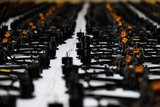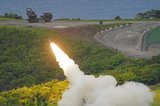Lockheed Martin TRACER completes UAS test flights
Lockheed Martin's Tactical Reconnaissance and Counter-Concealment-Enabled Radar, TRACER, has completed flight testing aboard a Predator B MQ-9 Unmanned Aerial System. TRACER is a dual-band (UHF and VHF) synthetic-aperture radar capable of detecting and geo-locating objects that are buried, camouflaged or concealed under foliage. Classified as a queuing sensor, TRACER processes images in real time, and can immediately down-link captured images to multiple ground stations. Prior to the MQ-9 UAS flight testing, TRACER had successfully completed 100 test flights on manned platforms.
"TRACER has demonstrated its long endurance, wide-area surveillance capability to detect targets in all operational environments - in any type of weather, day and night," said Jim Quinn, vice president of C4ISR Systems with Lockheed Martin's IS&GS-Defense. "TRACER will provide commanders with intelligence not currently available from higher frequency radars or electro-optical systems."
During the flight tests aboard the Predator B MQ-9, TRACER focused on identifying targets of interest that would be relevant to multiple theatres - including CENTCOM, PACOM, AFRICOM and SOUTHCOM. Over the course of the four month testing, the TRACER team validated the radar's performance in the harsh environment of an UAS configuration, thus mitigating risk for eventual installation on a tier IV UAS or other platforms, such as the YMQ-18Aunmanned aerial helicopter. During the tests the team also demonstrated satellite data link control of both the vehicle and radar system.
There are currently four qualified TRACER systems available for deployment on manned or unmanned platforms. TRACER was developed for the US Army's Intelligence and Information Warfare Directorate, based at Aberdeen Proving Grounds, Md.
The TRACER system's design is predicated on Lockheed Martin's operationally proven foliage penetration (FOPEN) system, which was developed specifically to detect vehicles, buildings, and large metallic objects in broad areas of dense foliage, forested areas and wooded terrain. The radar's advanced detection capability suppresses background clutter and returns from stationary objects, while revealing the positions of mobile and portable targets. Over the course more than 1,000 operational missions, the low frequency FOPEN radar system's detection and tomography capabilities have proven extremely robust against a variety of targets and foliage environments.
Source: Lockheed Martin
More from Uncrewed Vehicles
-
![What's next for the Pentagon after the Replicator programme?]()
What's next for the Pentagon after the Replicator programme?
Although the Replicator initiative has made several accomplishments, there are still multiple gaps to plug across the US Department of Defense (DoD) and its services.
-
![Cummings Aerospace showcases Hellhound loitering munition designed for US Army’s LASSO programme (video)]()
Cummings Aerospace showcases Hellhound loitering munition designed for US Army’s LASSO programme (video)
Cummings Aerospace presented its turbojet-powered Hellhound loitering munition at SOF Week 2025, offering a man-portable solution aligned with the US Army’s LASSO requirements.
-
![SOF Week 2025: PDW unveils attritable FPV drone for SOF operations at scale]()
SOF Week 2025: PDW unveils attritable FPV drone for SOF operations at scale
PDW has revealed its Attritable Multirotor First Person View drone at SOF Week 2025, offering special operations forces a low-cost, rapidly deployable platform for strike and ISR missions, inspired by battlefield lessons from Ukraine.
-
![SOF Week 2025: Teledyne FLIR white paper provides guidance on reusable loitering munitions]()
SOF Week 2025: Teledyne FLIR white paper provides guidance on reusable loitering munitions
Teledyne FLIR is highlighting the emerging requirements for 'recoverable and re-usable' loitering munitions across the contemporary operating environment during this week’s SOF Week conference in Tampa, Florida.
-
![SOF Week 2025: Kraken Technology group debuts K3 Scout USV in North America]()
SOF Week 2025: Kraken Technology group debuts K3 Scout USV in North America
High-performance maritime industry player Kraken Technology Group, based in the UK, has used the SOF Week conference in Tampa, Florida this week to debut its K3 Scout uncrewed surface vessel (USV) to the North American market.
-
![Palladyne AI and Red Cat to demonstrate capabilities for autonomous drone swarms to the US military]()
Palladyne AI and Red Cat to demonstrate capabilities for autonomous drone swarms to the US military
Red Cat and Palladyne AI recently conducted a cross-platform collaborative flight involving three diverse heterogeneous drones.

























